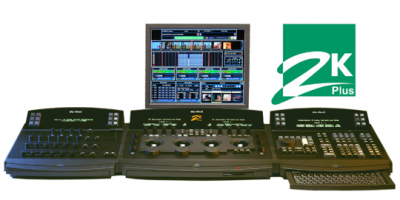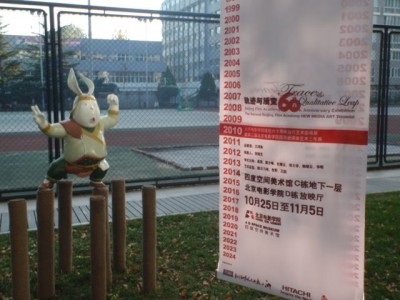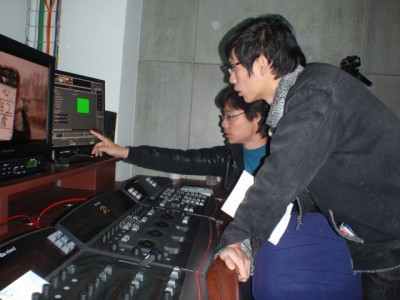 CC Chan from ACC in Hong Kong called me in December 2009 and said…
CC Chan from ACC in Hong Kong called me in December 2009 and said…
“I have the very last new DaVinci 2K Plus here in my office, it’s going into the BFA in Beijing, would you like to oversee the training?”
I thought of it as the end of an era, so said I’d love to, the only problem was would I remember how to use all that hardware? As it turned out I would have nearly a year to practice!
It is estimated that there are over 450 DaVinci 2K systems scattered around the world, making it the most widely used color corrector in history. Perhaps the only territory where it didn’t make an impact was in my home town of London where the Pandora Pogle dominated during that period. The very first 2K machine went into Modern Video in January 1999, and Kevin Shaw recalls it was installed to grade the Star Wars picture the “Phantom Menace”. My first 2K experience came in 2001 at Cutting Edge in Australia where we drove the Sony Vialta telecine, with great success. Although I have since heard some horror stories of the first few weeks after installation in 1999 where both the 2K and the Vialta were brand new products. I worked there for 4 years gaining lots of experience as we added Power Tiers a Defocus board, followed by a Toolbox.
 Jump forward to November 2010, 11 months from my initial conversation with ACC and the machine has finally been installed. The Beijing Film Academy is a film school that doubles as a post facility. They already had a Baselight 4 and a Pablo. The challenge I could see was getting these colorists who had already mastered non linear machines, to sort of work in reverse to the rest of the world and learn a telecine and a hardware color corrector after mastering the flexibility of non linear. The BFA 2K Plus had 1 Power tier and a Defocus board. I only had 3 days and could see I had my work cut out. On a personal note, I needn’t have worried, it had been 5 years since I had driven a 2K/Spirit combo on a daily basis but it is like driving a car. When you jump into a left hand drive manual, it’s strange for the first 30 minutes but after that it is like you were never away. The thing that struck me the most was how hard and long-winded the 2K seemed to be to drive. I started the training with a complete demo of the system using 35mm as the source material, recording to an HDCAM SR deck. The BFA colorists sat in silence, but in China that’s not a bad thing, they are showing respect, but soon the questions were coming thick and fast. It was very different for them, not only were they learning the 2K they also had to contend with the live telecine pictures coming off the Spirit. When training I never talk for more than 30 minutes when showing something, I am then out of the chair offering it to my students. Although very reluctant to be on show in front of their colleagues they were soon moving to the front and all taking a turn. If ever I left the room I would return to a 4 man huddle around the machine all talking together and offering advice to the colorist in the hot seat.
Jump forward to November 2010, 11 months from my initial conversation with ACC and the machine has finally been installed. The Beijing Film Academy is a film school that doubles as a post facility. They already had a Baselight 4 and a Pablo. The challenge I could see was getting these colorists who had already mastered non linear machines, to sort of work in reverse to the rest of the world and learn a telecine and a hardware color corrector after mastering the flexibility of non linear. The BFA 2K Plus had 1 Power tier and a Defocus board. I only had 3 days and could see I had my work cut out. On a personal note, I needn’t have worried, it had been 5 years since I had driven a 2K/Spirit combo on a daily basis but it is like driving a car. When you jump into a left hand drive manual, it’s strange for the first 30 minutes but after that it is like you were never away. The thing that struck me the most was how hard and long-winded the 2K seemed to be to drive. I started the training with a complete demo of the system using 35mm as the source material, recording to an HDCAM SR deck. The BFA colorists sat in silence, but in China that’s not a bad thing, they are showing respect, but soon the questions were coming thick and fast. It was very different for them, not only were they learning the 2K they also had to contend with the live telecine pictures coming off the Spirit. When training I never talk for more than 30 minutes when showing something, I am then out of the chair offering it to my students. Although very reluctant to be on show in front of their colleagues they were soon moving to the front and all taking a turn. If ever I left the room I would return to a 4 man huddle around the machine all talking together and offering advice to the colorist in the hot seat.
I was there to show them the 2K, not the Spirit but I found it very hard not to help with the telecine too. The BFA guys had experience working with film scans but had never driven a telecine and faced all the extra challenges that brings. We set up 4 basic 2K configs, tape to tape both 444/422 and a 35mm negative and positive config. I then built all the various scan sizes into the bottom half of the 26 scratch memories. This wasn’t easy as they didn’t have any Dell line up films, I am amazed DFT don’t supply charts and Kodak films with new machines?
 The way a 2K works is more complicated than most of the current grading systems as each option is a physical card in a large crate, so the pictures have to be routed into each board. This is the thing the guys found hardest, remembering what window came from which board. They all agreed that it was harder than their Baselight to drive but at the same time could see the dual sync advantages for dailies when driving the Spirit.
The way a 2K works is more complicated than most of the current grading systems as each option is a physical card in a large crate, so the pictures have to be routed into each board. This is the thing the guys found hardest, remembering what window came from which board. They all agreed that it was harder than their Baselight to drive but at the same time could see the dual sync advantages for dailies when driving the Spirit.
Day 3 was all hands on. I rotated the Colorists giving each a different task, from making a new user right up to sending a Power Window and key from the SV board into the defocus board. (Had to rack my brain there!)
Overall the 3 days went very well, a steep learning curve for the guys. Their advantage is that as a 4 man team, if somebody forgets something, one of the others will remember it, if not they can always call me.





